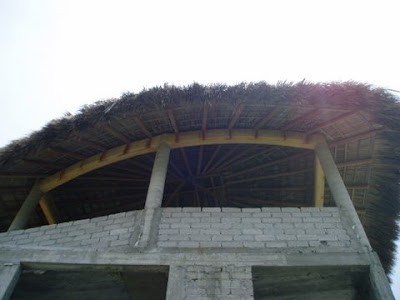




April to August. It wouldn't be fair to say that nothing went on during this time, because there was a lot of planning, learning about rainy season runoff flows, the first vegetation planting -- bouganvillas along the west boundary in by the neighbor's house -- all of that happened. But lets say the cash flow rate was radically decreased for a while. As the calendar pages turned, however, the goal of having the top level -- the palapa level -- ready for occupancy this winter, started to look attainable (because my workload increased enough for the cash flow to resume). We decided to stick with the plan of mixing yellow colorant in the top layer of stucco, and we figured that the upper beams needed that treatment before they built the palapa. A linguistic note: a palapa roof is the local type of thatched roof, made from palm fronds (specifically from the royal palm) tied down to small sticks laid horizontally over larger wooden rafters. The word palapa refers both to the roof and to the structure, or in this case the top floor of the structure, it shelters. The palapa system sheds water perfectly, and looks great. It is hoped to last 10-15 years which doesn't seem long, but the other choices -- metal, spanish tile, concrete, -- all cost more and do not have indefinite lives in that climate either. One real advantage is in hurricanes: the palms will rip from the small sticks, and the small sticks from the big ones, sequentially. Imagine being anywhere the destruction of a metal or tile roof in a hurricane for a moment and the advantage is clear.
In August the palperos started to get the wood -- amazing long straight trunks, 5 or 6" diameter, of a tropical hardwood too dense to float in water which is chosen for termite resistance -- and Lencho's crew got busy stuccoing the beams. The photos show the progress, from wood to framing to inside and outside views of the finished work. I just wished I could have been there to see it happen. Derek had the idea of adding the gable-type vents on the east and west to encourage ventilation, which can't hurt, though with no walls on three sides it's not clear to me just how hot it could really get in there. Anyway I should have the chance to see some palapa construction later as there will also be shed roofs like this over the west and north parts of the 2nd floor deck, hopefully this winter sometime.
Liz and I have stayed in 2nd and 3rd floor apartments in different parts of Puerto several times over the years and always enjoyed the open air, views, and just lying back looking at the roof details. There are no metal fasteners above the threaded rods which hold each rafter to the concrete beam; all joints are tied together with natural fibers, mostly palm leaves, I think. It is a trade and craft one can appreciate from several angles.
1 comment:
awesome to see it coming together
you must be so excited!!
Post a Comment